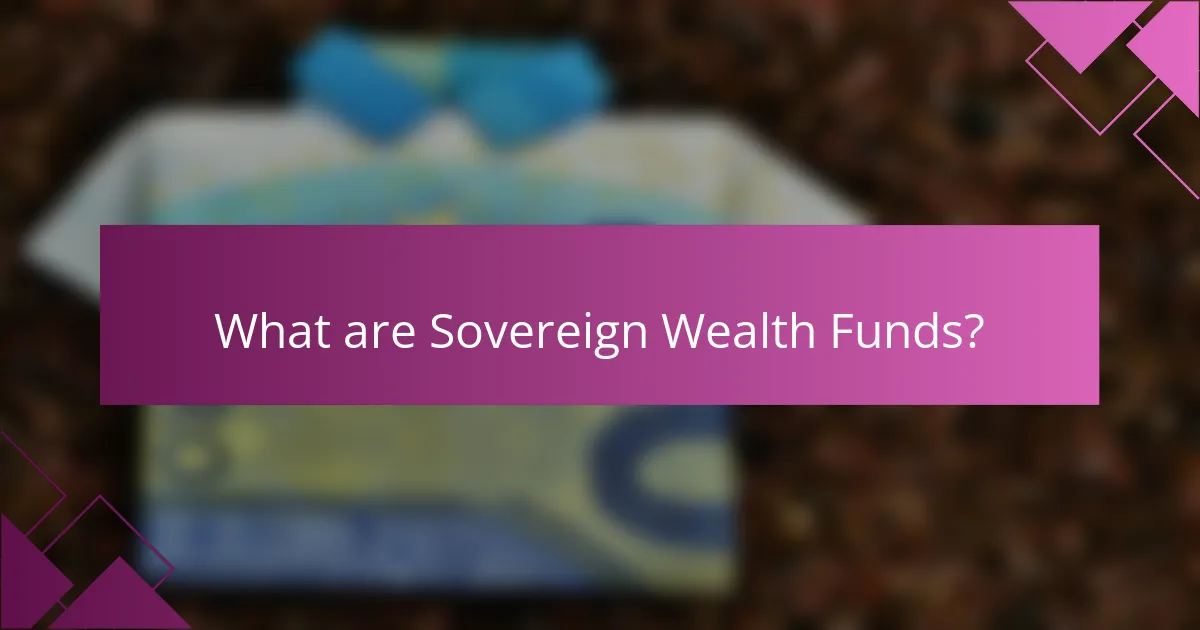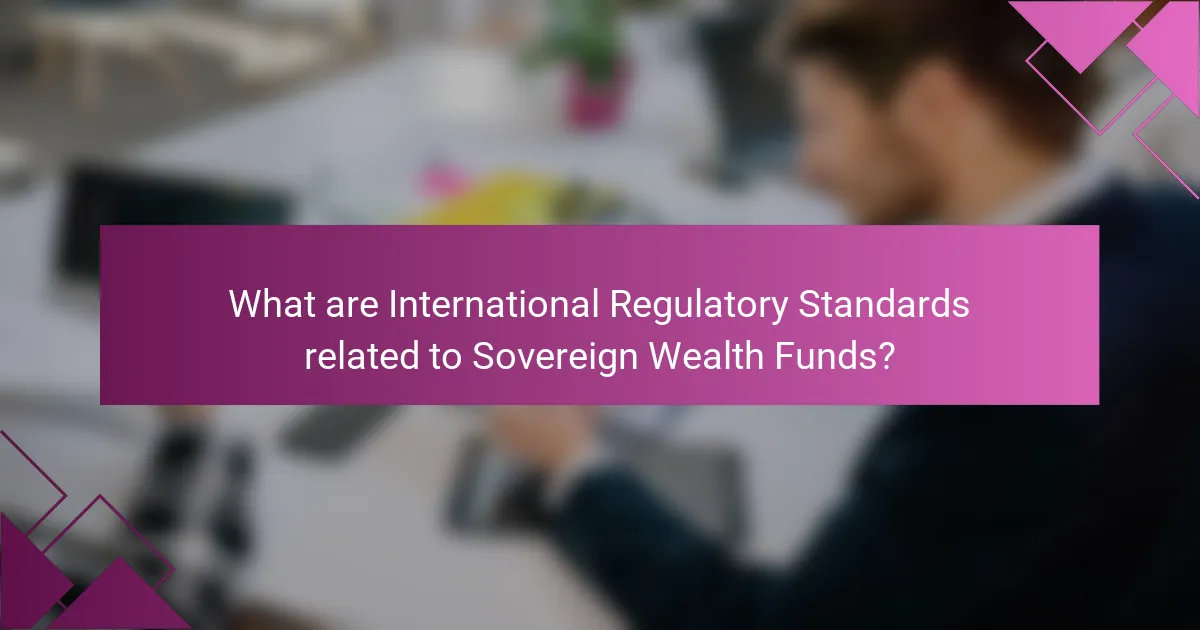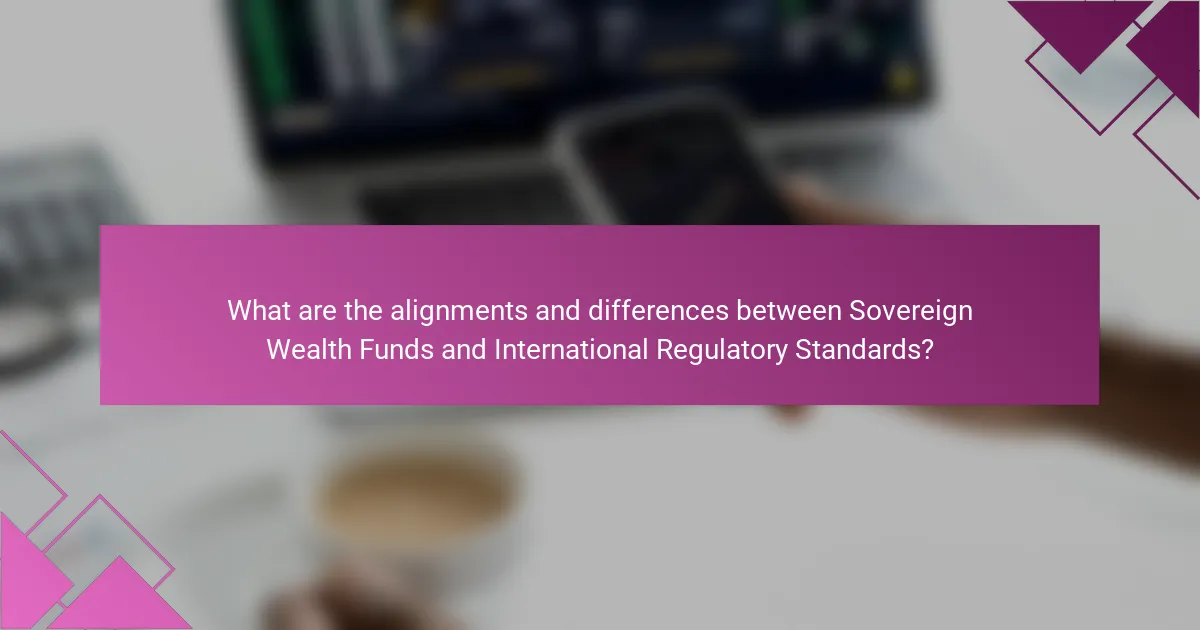
What are Sovereign Wealth Funds?
Sovereign Wealth Funds are state-owned investment funds or entities. They invest in various assets to generate returns for the country. These funds are typically funded by surplus revenues from natural resources or foreign exchange reserves. For example, Norway’s Government Pension Fund Global is one of the largest sovereign wealth funds. As of 2023, it manages over $1 trillion in assets. Sovereign Wealth Funds aim to stabilize the economy and provide future generations with wealth. They also play a role in global financial markets through investments in stocks, bonds, and real estate.
How do Sovereign Wealth Funds operate?
Sovereign Wealth Funds (SWFs) operate by managing national savings for investment purposes. These funds are typically funded by government revenues, such as oil exports or foreign exchange reserves. SWFs invest in a variety of assets, including stocks, bonds, real estate, and infrastructure projects. Their primary goal is to generate returns to support the economy and future generations.
SWFs are often governed by specific investment strategies and risk management frameworks. They may focus on long-term growth, liquidity, or diversification of assets. Many SWFs adhere to the Santiago Principles, which promote transparency and accountability. According to the International Working Group of Sovereign Wealth Funds, these principles guide SWFs in their operations and interactions with other financial markets.
In summary, SWFs operate by investing national savings in diverse assets, guided by specific strategies and principles to optimize returns and support economic stability.
What are the primary sources of funding for Sovereign Wealth Funds?
Sovereign Wealth Funds are primarily funded through government revenues. These revenues often originate from natural resource exports, such as oil and gas. Additionally, they can be funded by fiscal surpluses from government budgets. Some funds receive proceeds from privatizations of state-owned enterprises. Another source includes returns from existing investments. Countries may also allocate a portion of foreign exchange reserves to these funds. These funding sources ensure that Sovereign Wealth Funds can invest for long-term economic stability.
What investment strategies do Sovereign Wealth Funds typically employ?
Sovereign Wealth Funds typically employ a diversified investment strategy. They allocate capital across various asset classes, including equities, fixed income, real estate, and alternative investments. This diversification helps mitigate risks and optimize returns. Many Sovereign Wealth Funds also invest in private equity and infrastructure projects for long-term growth. They often pursue a strategic asset allocation approach, balancing risk and return based on their investment objectives. Additionally, some funds engage in active management to capitalize on market inefficiencies. For instance, the Norway Government Pension Fund Global employs a responsible investment strategy, integrating environmental, social, and governance factors into its decision-making process.
What is the role of Sovereign Wealth Funds in the global economy?
Sovereign Wealth Funds (SWFs) play a crucial role in the global economy by managing national savings for investment purposes. They provide a source of capital for both domestic and international markets. SWFs typically invest in a variety of assets, including stocks, bonds, real estate, and infrastructure projects. This diversification helps stabilize economies during financial downturns. According to the Sovereign Wealth Fund Institute, as of 2023, SWFs manage over $10 trillion in assets globally. Their investments can influence market trends and provide liquidity. Additionally, SWFs often contribute to economic development in their home countries by funding public projects. They also engage in responsible investing, promoting sustainable practices across industries.
How do Sovereign Wealth Funds influence international markets?
Sovereign Wealth Funds (SWFs) influence international markets by investing large sums of capital in various asset classes. These funds, managed by national governments, often target equities, bonds, real estate, and infrastructure projects. Their investment decisions can significantly impact stock prices and market liquidity. For instance, the Government Pension Fund of Norway, one of the largest SWFs, holds substantial stakes in major global companies. This level of investment can lead to increased market confidence and stability. Additionally, SWFs often engage in long-term investment strategies, which can foster sustainable economic growth. Their influence is further amplified by their ability to mobilize capital quickly in response to market opportunities. In 2020, SWFs collectively managed over $9 trillion in assets, showcasing their substantial role in global finance.
What impact do Sovereign Wealth Funds have on domestic economies?
Sovereign Wealth Funds (SWFs) can significantly impact domestic economies. They provide capital for infrastructure projects, which stimulates economic growth. SWFs often invest in various sectors, creating jobs and enhancing productivity. They can stabilize economies during financial crises by providing liquidity. SWFs also contribute to government revenues through dividends and taxes. For instance, Norway’s Government Pension Fund has funded public services through its returns. Additionally, SWFs can influence domestic policies by promoting sustainable investments. Their presence can attract foreign direct investment, further boosting economic development.

What are International Regulatory Standards related to Sovereign Wealth Funds?
International regulatory standards related to sovereign wealth funds (SWFs) primarily focus on governance, transparency, and accountability. The International Working Group of Sovereign Wealth Funds (IWG) established the Santiago Principles in 2008. These principles provide a framework for the governance of SWFs. They emphasize the importance of promoting good governance, accountability, and transparency in the management of SWFs.
The Santiago Principles include 24 principles that cover aspects such as investment policies, risk management, and ethical behavior. They aim to enhance the understanding of SWFs among various stakeholders. Furthermore, adherence to these standards is seen as a way to foster trust and mitigate concerns related to the investment activities of SWFs.
Countries that adopt these principles often report improved practices in their SWF operations. The principles have been endorsed by numerous countries, signifying a global commitment to responsible SWF management.
How are these standards developed and implemented?
Standards for sovereign wealth funds are developed through a collaborative process involving multiple stakeholders. These stakeholders typically include governments, international organizations, and industry experts. The process begins with the identification of best practices and existing frameworks. This is followed by consultations and discussions to gather input and consensus.
Implementation occurs through the adoption of these standards by sovereign wealth funds. Funds incorporate the standards into their operational practices and governance structures. They may also undergo assessments to ensure compliance with the agreed-upon standards. Regular reviews and updates are conducted to adapt to evolving market conditions and regulatory environments.
For instance, the International Working Group of Sovereign Wealth Funds published the Santiago Principles in 2008, which serve as guidelines for sound governance and accountability.
What organizations are involved in setting these regulatory standards?
The organizations involved in setting regulatory standards for sovereign wealth funds include the International Monetary Fund (IMF), the Organisation for Economic Co-operation and Development (OECD), and the International Working Group of Sovereign Wealth Funds (IWG). The IMF provides guidelines on fiscal policies and transparency. The OECD develops principles for responsible investment and governance. The IWG, through the Santiago Principles, establishes best practices for fund management. These organizations collaborate to enhance accountability and promote sound investment practices globally.
How do different countries approach these international standards?
Different countries approach international standards for sovereign wealth funds (SWFs) with varying degrees of alignment and adaptation. Some countries, like Norway, strictly adhere to the Santiago Principles, emphasizing transparency and accountability. Others, such as China, adopt a more flexible approach, prioritizing national interests over strict compliance. The United States also showcases a diverse approach, with states like Alaska following the Principles while others maintain less stringent regulations. Countries in the Gulf region often implement standards that reflect their unique economic contexts, balancing international expectations with local governance. This divergence highlights the complexity of global financial governance and the influence of national priorities on compliance.
Why are regulatory standards important for Sovereign Wealth Funds?
Regulatory standards are important for Sovereign Wealth Funds (SWFs) because they ensure transparency and accountability. These standards provide a framework for ethical investment practices. They help mitigate risks associated with political and economic instability. Compliance with regulatory standards enhances investor confidence. It also promotes responsible management of public assets. For instance, the International Working Group of Sovereign Wealth Funds established the Santiago Principles. These principles guide SWFs in achieving good governance and accountability. Countries with strong regulatory frameworks tend to attract more foreign investment. This fosters economic growth and stability.
What risks do unregulated Sovereign Wealth Funds pose?
Unregulated Sovereign Wealth Funds pose significant risks to global financial stability. Their lack of oversight can lead to market manipulation and increased volatility. Unregulated funds may also engage in investments that conflict with national interests. This behavior can result in geopolitical tensions. Additionally, the opacity of these funds can obscure their financial health. This lack of transparency raises concerns among investors and regulators. Historical instances, such as the 2008 financial crisis, demonstrate the potential fallout from unregulated entities. Overall, unregulated Sovereign Wealth Funds can destabilize economies and undermine investor confidence.
How do regulatory standards enhance transparency and accountability?
Regulatory standards enhance transparency and accountability by establishing clear guidelines for reporting and governance. These standards require entities to disclose financial information regularly. This disclosure allows stakeholders to assess performance and risks effectively. Regulatory frameworks often include audits and compliance checks. Such measures ensure that entities adhere to established rules. In turn, this fosters trust among investors and the public. For example, the International Financial Reporting Standards (IFRS) promote uniformity in financial reporting across jurisdictions. This uniformity aids in comparing financial statements globally, enhancing transparency. Overall, regulatory standards create a structured environment for accountability and informed decision-making.

What are the alignments and differences between Sovereign Wealth Funds and International Regulatory Standards?
Sovereign Wealth Funds (SWFs) and International Regulatory Standards (IRS) align in their goals of promoting financial stability and responsible investment practices. SWFs aim to manage national savings for long-term benefit. They often adhere to principles of transparency and accountability, which align with IRS that promote similar values. However, differences exist in their operational frameworks. SWFs are often state-owned and can pursue strategic national interests. In contrast, IRS are typically established by international bodies to regulate financial practices across jurisdictions. The regulatory standards do not dictate how SWFs should operate but provide guidelines for best practices. This distinction highlights that while both entities share common goals, their approaches and governance structures differ significantly.
What are the common goals of Sovereign Wealth Funds and regulatory standards?
The common goals of Sovereign Wealth Funds (SWFs) and regulatory standards include promoting financial stability and ensuring transparency. SWFs aim to manage national savings for long-term wealth generation. Regulatory standards seek to establish frameworks that enhance accountability and governance. Both entities prioritize risk management to safeguard investments. They also strive to align with global best practices to foster trust among stakeholders. Furthermore, they share a commitment to sustainable investment practices. This alignment helps mitigate systemic risks in the financial system. Overall, their goals converge on enhancing economic resilience and fostering sustainable development.
How do Sovereign Wealth Funds align with global financial stability?
Sovereign Wealth Funds (SWFs) contribute to global financial stability by providing liquidity and acting as stabilizers during economic downturns. They invest in diverse asset classes across various markets. This diversification helps mitigate systemic risks. SWFs often hold significant long-term investments, which can buffer against market volatility. For instance, during the 2008 financial crisis, SWFs invested in distressed assets, supporting financial institutions. Their investments can enhance capital flows to emerging markets, fostering economic growth. Additionally, SWFs adhere to international best practices, promoting transparency and accountability. This alignment with global standards boosts investor confidence and stability in financial systems.
What differences exist in regulatory approaches across countries?
Regulatory approaches to sovereign wealth funds differ significantly across countries. Some nations implement strict governance frameworks to ensure transparency and accountability. For instance, Norway’s Government Pension Fund Global adheres to a comprehensive set of ethical guidelines. In contrast, other countries may have minimal regulations, allowing for greater discretion in fund management. The United States, for example, lacks a federal regulatory framework specifically for sovereign wealth funds, leading to varied state-level approaches. Additionally, some countries prioritize economic stability, while others focus on maximizing returns. These differences can impact investment strategies and international relations. Countries like Singapore emphasize sustainable investment practices, while others may prioritize short-term gains.
What implications do these alignments and differences have?
The alignments and differences in sovereign wealth funds (SWFs) and international regulatory standards have significant implications for global finance. These implications include varying levels of transparency and accountability among SWFs. For instance, countries with stringent regulations may foster greater investor confidence. Conversely, less regulated SWFs may face scrutiny and challenges in attracting foreign investment.
Additionally, alignment with international standards can enhance the reputation of SWFs. This can lead to improved access to global capital markets. Differences may create competitive advantages for certain SWFs, allowing them to operate with less oversight. This could result in potential risks, such as increased volatility in financial markets.
Moreover, the implications extend to geopolitical relations. Countries that align closely with international standards may strengthen diplomatic ties. On the other hand, significant differences could lead to tensions or conflicts regarding investment practices. Overall, these alignments and differences shape the operational landscape for SWFs and influence their interactions on the global stage.
How do these implications affect global investment flows?
Implications of sovereign wealth funds and international regulatory standards significantly influence global investment flows. Enhanced regulatory alignment can increase investor confidence. This leads to higher capital inflows into countries with stable regulations. Conversely, differing standards may deter investment due to perceived risks. For example, countries with stringent regulations may attract more investments. According to the International Monetary Fund, countries with clear regulatory frameworks see a 20% increase in foreign direct investment. Additionally, regulatory mismatches can create barriers, resulting in reduced investment opportunities.
What challenges arise from regulatory differences for Sovereign Wealth Funds?
Regulatory differences create several challenges for Sovereign Wealth Funds (SWFs). These challenges include compliance costs, legal risks, and operational complexities. SWFs must navigate varying regulations across jurisdictions. This can lead to increased expenses related to legal advice and compliance measures. Additionally, inconsistent regulations may expose SWFs to legal risks. For example, differing definitions of investment restrictions can complicate portfolio management. Operational complexities arise when SWFs must adapt to multiple regulatory environments. This can hinder investment strategies and reduce efficiency. Furthermore, regulatory discrepancies can impact transparency and accountability. Such challenges may ultimately affect the performance and reputation of SWFs in the global market.
What best practices can Sovereign Wealth Funds adopt to comply with international standards?
Sovereign Wealth Funds can adopt several best practices to comply with international standards. First, they should implement transparent governance structures. This includes clear decision-making processes and accountability mechanisms. Second, they should adhere to the Santiago Principles. These principles promote good governance, accountability, and transparency in SWFs. Third, regular audits and independent evaluations are essential. They help ensure compliance with established standards and enhance credibility. Fourth, engaging with stakeholders is crucial. This includes communication with the public and other investors to build trust. Finally, continuous education and training for staff on international regulations are necessary. This ensures that personnel are well-informed about compliance requirements.
How can Sovereign Wealth Funds enhance their governance structures?
Sovereign Wealth Funds can enhance their governance structures by implementing best practices in transparency and accountability. Establishing clear investment policies is essential for guiding decision-making. Regular audits and independent evaluations help ensure compliance with these policies. Engaging with stakeholders fosters trust and promotes better governance outcomes. Additionally, adopting international standards, such as the Santiago Principles, can improve operational frameworks. Training and capacity-building for governance personnel enhance their effectiveness. Research indicates that funds with strong governance frameworks achieve better long-term performance. For instance, a study by the International Monetary Fund highlighted that effective governance correlates with improved fund returns.
What role does stakeholder engagement play in compliance with regulations?
Stakeholder engagement is essential for ensuring compliance with regulations. It fosters communication between entities and regulatory bodies. This communication helps in understanding regulatory requirements better. Engaging stakeholders can lead to more effective policy development. It also enables organizations to identify potential compliance issues early. Research shows that organizations with robust stakeholder engagement processes have higher compliance rates. For instance, a study by the Harvard Law School Forum on Corporate Governance found that effective stakeholder engagement reduces legal risks. Thus, stakeholder engagement plays a critical role in navigating regulatory landscapes successfully.
Sovereign Wealth Funds (SWFs) are state-owned investment entities that manage national savings to generate returns and stabilize economies. This article explores the operational mechanisms of SWFs, their primary funding sources, and investment strategies, highlighting their significant role in the global economy and domestic markets. Additionally, it examines international regulatory standards, particularly the Santiago Principles, and their implications for governance, transparency, and accountability in SWF operations. The analysis addresses the alignments and differences between SWFs and these standards, as well as the challenges and best practices for compliance, ultimately emphasizing the impact on global investment flows and financial stability.
